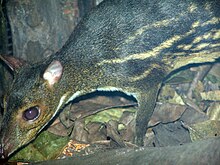
Etymology
Chevrotain is a French word that means "little goat".The single African species is consistently known as "chevrotain".[1][4][6] The names "chevrotain" and "mouse-deer" have been used interchangeably among the Asian species,[4][7][8][9] though recent authorities typically have preferred chevrotain for the species in the genus Moschiola and mouse-deer for the species in the genus Tragulus.[1] Consequently, all species with pale-spotted or -striped upper parts are known as "chevrotain" and without are known as "mouse-deer".
The Telugu name for the Indian spotted chevrotain is jarini pandi, which literally means "a deer and a pig".[citation needed] In Kannada, it is called barka (ಬರ್ಕ), in Malayalam, it is called khooran, and the Konkani name for it is barinka. The Tamil term is சருகு மான் sarukumāṉ "leaf-pile deer". The Sinhalese name meeminna roughly translates to "mouse-like deer". This was used in the scientific name of the Sri Lankan spotted chevrotain, M. meminna.
Biology
The family is widespread and successful from the Oligocene (34 million years ago) through the Miocene (about 5 million years ago), but has remained almost unchanged over that time and remains as an example of primitive ruminant form. They have four-chambered stomachs to ferment tough plant foods, but the third chamber is poorly developed. Though most species feed exclusively on plant material, the water chevrotain occasionally takes insects and crabs, or scavenges meat and fish.[10] Like other ruminants, they lack upper incisors. They give birth to only a single young.In other respects, however, they have primitive features, closer to nonruminants such as pigs. All species in the family lack antlers and horns, but both sexes have elongated canine teeth. These are especially prominent in males, where they project out on either side of the lower jaw, and are used in fights.[4] Their legs are short and thin, which leave them lacking in agility, but also helps to maintain a smaller profile to aid in running through the dense foliage of their environments. Other pig-like features include the presence of four toes on each foot, the absence of facial scent glands, premolars with sharp crowns, and the form of their sexual behaviour and copulation.[11]
Mating mouse-deer
Some of the species show a remarkable affinity with water, often remaining submerged for prolonged periods to evade predators or other unwelcome intrusions. This has also lent support to the idea that whales evolved from water-loving creatures that looked like small deer.[12][13]
Taxonomy
Traditionally, only four extant species were recognized in the family Tragulidae.[4] In 2004, T. nigricans and T. versicolor were split from T. napu, and T. kanchil and T. williamsoni were split from T. javanicus.[14] In 2005, M. indica and M. kathygre were split from M. meminna.[2] With these changes, the 10 extant species are:
Indian spotted chevrotain
Tragulus sp.
- Family Tragulidae



No comments:
Post a Comment
Note: Only a member of this blog may post a comment.